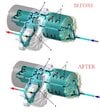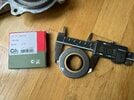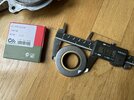There is likely a very robust EV motor coolant seal technology that already exist. However, it is unlikely the aftermarket or DIY community can access it. But I'll post it here. Those in EU might have better luck to engage with the much more mature right to repair culture and potentially more dialog.
EKK
EKK is a $1B+ Japanese company with range of high precision capabilities. With today's global supply chain and diverse product grades. JP and EU machinery companies are focused on high precision higher sophistication products. EKK have absorbed many high precision capabilities world wide including in US and likely EU. Therefore have many development centers and several divisions to serve high end markets (aerospace, marine, semiconductor, high end machinery, and automotive) This particular seal technology is likely developed in Japan per technical paper author's location (Saitama Japan, outside Tokyo)
Patterned Surface Face Seal
They have developed a very advanced face seal directly aimed at running coolant through the rotors. In fact, many diagrams clearly refers to the problematic LDU.
This face seal has micro patterns on the sealing face to control both fluid AND aero dynamic behavior to pump the media (seal design terminology : coolant in case of LDU) constantly towards the wet side. It uses fluid dynamics at low speed and aero dynamics at high speed. If you think about how to make low friction seal, the ideal design is to have low to no fraction contact between surface. A best way to achieve this is provide a pump mechanism to constantly push the wet stuff back to prevent leaking to the dry side. ( You actually want the wet stuff near the sealing surface for lubrication and heat removal to not burn up the seal material and structure )
Bottom of the following link includes link to download 2 technical papers (require registration) that goes over in great detail on engineering design theory, testing, evaluation, and analysis of the seal. The 2nd link is much more general glossary of their capabilities. This whole field of science is called "tribology"
This page introduces GlideX™-EMS, RGS. Eagle Industry is a comprehensive manufacturer of mechanical seals and equipment products. Our technologies and products are used in the automotive, marine, rocket/aircraft, and various industries around the world.
www.ekkeagle.com
This page introduces Surface Textured Mechanical Seal. Eagle Industry is a comprehensive manufacturer of mechanical seals and equipment products. Our technologies and products are used in the automotive, marine, rocket/aircraft, and various industries around the world.
www.ekkeagle.com
These designs are far beyond choosing advanced seal materials or simple lip/face seal shapes. It is creating complex fluid and aero dynamic behaviors to lubricate, cool, and pump media away from the dry side. I'd imagine requiring a significant R&D center staffed by many post graduate level skills in tribology and likely far beyond most small/medium size companies.
Likely OEM Only
Came across this design over a year ago and have been trying to reach out to this company. Their communication access in US is definitely not for end consumers or small companies. It is likely they mostly engage with large manufacturers and very high end equipment manufacturers.
They have EU subsidiary which might be more accessible if any EU member want attempt to engage. But I'm guess no standard available parts. Large OEM manufacturer engagement only. But EU's more mature right to repair culture likely create more dialog opportunity than here in US.
GlideX™ Surface Textured Face Seals are designed for sealing fluids used in EV drive motor cooling or gearbox systems.<br /> The seal's textured sliding surface provides superior sealing performance together with extremely low torque.<br /> Its non-contact sealing under rotation reduces sliding...

www.ekk-europe.com





